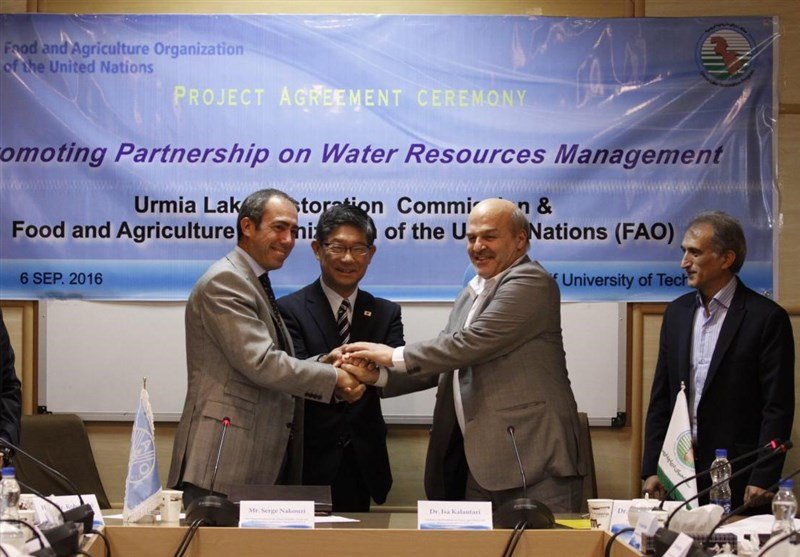FAO launches four-year holistic program to save Urmia Lake

FAO signed an agreement on Tuesday (6 September 2016), with the Urmia Lake Restoration Commission (ULRC) in Tehran at Sharif University of Technology to lend substantive technical assistance for the execution of an integrated programme that aims ultimately to secure sustainable water resources management in the Urmia Lake basin.
At the ceremony, Mr. Serge Nakouzi, the FAO Representative to the Islamic Republic of Iran and to the Economic Cooperation Organization (ECO), and Dr. Issa Kalantari, Adviser to the Iranian President on Water, Agriculture and Environment and Secretary of Urmia Lake Restoration Commission (ULRC) signed the agreement and the project documents in the presence of His Excellency Hiroyasu Kobayashi, Ambassador of Japan to Iran.
“The project will accelerate halting and inverting the lake’s drying-up process by targeting reduction of water consumption within the Urmia Lake basin” the FAO Representative said.
Mr. Nakouzi underscored that through the implementation of the Programme, the concerned stakeholders will be empowered with tools and methodologies to monitor water consumption, agricultural water productivity and drought, while enhancing their capacity to disseminate Good Agricultural Practices (GAP) in agricultural water management.
The joint FAO – ULRC Programme that entitled “the Integrated Programme for Sustainable Water Resources Management in the Lake Urmia Basin” also comprises a socio-economic component that seeks to promote sustainable alternative income-generating solutions.
The Programme which funded by the Government of Japan with 436 million Japanese Yen (approx. 3.8 million USD), will be implemented by the Government of Iran with the support of the FAO technical and operational team, fully integrated within the existing governance of the Urmia Lake Restoration Programme (ULRP) and in close cooperation with different partners, selected on the basis of multidisciplinary requirements.
The area and volume of Urmia Lake is the resulting net balance of the amount of inflowing and outflowing water. For hundreds and perhaps thousands of years, the Urmia Lake was in balance with its water supply from the watershed, but recent increases in agricultural, industrial and municipal water withdrawals have disturbed the balance and the Urmia Lake is drying up. Consequently, the most urgent need is to restore the water inflow to the Urmia Lake.
Following an official communication from the ULRC to the FAO Representation in the Islamic Republic of Iran, expressing concerns for the extreme water depletion/degradation of the Urmia Lake and requesting Organization’s assistance in finding possible solutions to the problem, a multidisciplinary mission was organized in February 2015 to respond to this request.
A rapid assessment on the status and prospects of the Urmia Lake was conducted by a team of FAO experts within the framework of the FAO Regional Initiative on Water Scarcity, as Islamic Republic of Iran became one of the recent focus countries of the Regional Initiative.
The findings of such a rapid assessment reaffirmed that the restoration of Urmia Lake is firmly anchored to the whole-basin water balance (inflow-outflow), particularly through addressing the dual core challenges of firstly, reducing water consumption of development activities upstream the lake; and secondly, managing drought, climate variability, and related risks for reduced precipitations.
Inter-basin water transfer would represent an additional variable of the water-balance equation, provided proper impact assessment is carefully considered. Water quality deserves due attention as well.
The ultimate beneficiaries of the project will be the Urmia Lake basin communities, who will benefit from information and decision support systems to target interventions reducing water consumption while restoring the Urmia Lake and its wetlands.
Throughout implementation of the project, special emphasis will be given to the inclusion of valuable alternative income-generation scenarios and employment options, cropping system revisions, and value chain improvement for farmers, rural population, and other socio-economic entities, to achieve the pre-determined target of water consumption reduction.
Leave a Comment